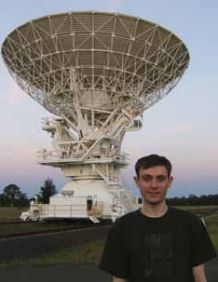Smart start for physics researcher

Not many students can claim that they have helped unravel mysteries in space or had their work published in top scientific journals before finishing their undergraduate degree, but Luke Pratley has done both.
The 20-year-old physics student is a co-author on two scientific papers and lead author on a third for radio astronomy research he’s been doing over the last three years under the guidance of Victoria astronomer Dr Melanie Johnston-Hollitt.
Luke’s ground-breaking work is in understanding more about radio galaxies, which send out electromagnetic radiation or radio waves. Some of them have a black hole at their centre and streaming from it are jets or plumes made up of electrons travelling close to the speed of light. They are, says Luke, one of the largest structures in the universe.
Luke went to Australia to create computer images of the jets using radio wave data from the Australia Telescope Compact Array, the most sensitive radio telescope in the Southern Hemisphere.
The images show the jets are not in a straight line, but are bent in different directions, or sometimes in a spiral, says Luke.
"The unusual shapes result from a range of different forces acting on the galaxy, including winds that are similar to a massive front."
Luke’s other work also fed into an international initiative that has successfully produced the highest precision map ever of the Milky Way galaxy’s magnetic field.
Persistence was partly why opportunities came his way, says Luke, who is now a fourth-year Honours student.
"I decided in my first year I wanted to do more than just classroom work and said that to staff, including Melanie. I reminded her I was keen to volunteer every time I saw her.
"The research gave me extra motivation to study because I wanted the background knowledge to help me problem-solve."
